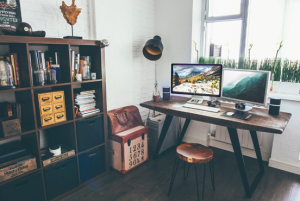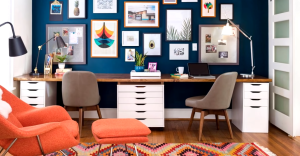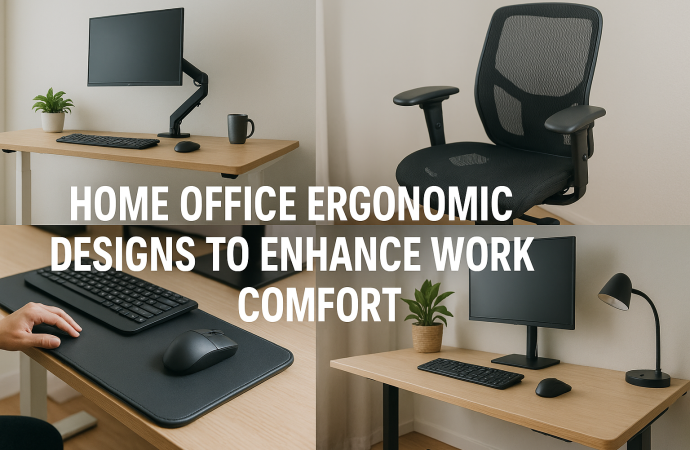Introduction Hours at a laptop can stiffen necks, cramp wrists, and drain focus—especially if your home “desk” is a kitchen counter or couch cushion. The good news: smart ergonomic design turns even a tiny spare corner into a body-friendly command center. By matching furniture height to your frame, adding task lighting, and breaking long sits
Introduction
Hours at a laptop can stiffen necks, cramp wrists, and drain focus—especially if your home “desk” is a kitchen counter or couch cushion. The good news: smart ergonomic design turns even a tiny spare corner into a body-friendly command center. By matching furniture height to your frame, adding task lighting, and breaking long sits with gentle movement, you protect joints and lift energy all day. This guide explains the basics of home office ergonomics in simple, clear steps. Whether you work full-time remote or tackle weekend side projects, you will learn how to set up a space that keeps you comfortable, healthy, and ready to do your best work.
Why Ergonomics Matters
Reduce Pain and Injury
Poor posture strains muscles and compresses nerves, leading to back aches, carpal-tunnel tingles, and tension headaches. Ergonomic tweaks spread pressure evenly and keep joints in neutral positions, cutting risk of chronic pain.
Boost Productivity and Mood
A chair that supports your lumbar curve and a screen that meets your eyes prevent slump-induced fatigue. When the body feels good, the brain focuses longer and stress levels drop.
Long-Term Health
Frequent micro-movements and proper alignment improve blood flow, lowering chances of circulatory problems linked to prolonged sitting.
Core Ergonomic Elements

Image by: Yandex.com
1. Adjustable Chair
- Seat height: Feet flat, knees at 90° angles.
- Lumbar support: Cushion fits natural lower-back curve.
- Armrests: Height so shoulders stay relaxed, elbows near 90°.
- Seat depth: Two-finger gap between chair edge and back of knees.
2. Desk and Work Surface
- Height: Forearms parallel to floor when typing. Standard desks (29-30 in) suit users 5′8″–6′. Shorter or taller workers need adjustable desks or keyboard trays.
- Depth: At least 24 in to hold monitor arm’s reach.
- Sit-stand option: Motorized desks let you switch every 30–45 minutes, easing spine load.
3. Monitor Placement
- Top line of text: Eye level or slightly below.
- Distance: About an arm’s length (20–28 in).
- Dual screens: Center between them or angle equally to avoid neck twist.
4. Keyboard and Mouse
- Keyboard angle: Flat or negative tilt to keep wrists straight.
- Mouse shape: Fits hand size; wrist rests offer extra support.
- Position: Close to body; avoid reaching.
5. Lighting and Glare Control
- Ambient light: Soft, even; avoid harsh ceiling glare.
- Task lamp: Adjustable LED aimed at documents.
- Screen glare: Place monitor perpendicular to windows; add matte filters when needed.
6. Movement and Breaks
- Micro-breaks: 30 seconds to stretch every 20 minutes.
- Posture shifts: Alternate standing and sitting.
- Eye rest: 20-20-20 rule—look 20 ft away for 20 seconds every 20 minutes.
Setting Up Your Space Step by Step

Image by: Yandex.com
Step 1 – Measure Yourself
Sit upright against a wall. Measure eye height, elbow height, and seat-to-knee length. Match these to chair and desk specs for a custom fit.
Step 2 – Adjust the Chair
Raise seat until elbows line with desk. Slide lumbar pad to cradle lower back. Confirm feet rest flat; add a footrest if toes dangle.
Step 3 – Align Desk and Keyboard
Place keyboard so wrists stay straight when elbows rest at desk edge. Add a keyboard tray if desk is too tall.
Step 4 – Position the Monitor
Use a riser or reams of paper to lift screen until top bezel meets eye height. Angle screen back 10–20° to reduce neck flex.
Step 5 – Organize Tools
Keep mouse close to keyboard. Store frequently used items (phone, notepad) within easy reach to avoid repetitive twisting.
Step 6 – Fine-Tune Lighting
Position task lamp on opposite side of writing hand to prevent shadows. Close blinds during midday glare.
Ergonomic Accessories Worth Considering
- Portable laptop stand—creates eye-level screen for travel or couch sessions.
- Anti-fatigue mat—softens pressure when standing.
- Document holder—places papers at monitor height to cut head tilt.
- Cable management clips—prevent tripping and clutter.
Choosing Ergonomic Furniture on a Budget
| Item | Budget Pick (USD) | Mid-Range (USD) | Premium (USD) |
|---|---|---|---|
| Task Chair | 120–180 | 300–500 | 900+ |
| Electric Sit-Stand Desk | 250–400 | 500–800 | 1,200+ |
| Monitor Arm | 40–70 | 100-150 | 250+ |
| Foot Rest | 20–35 | 50 | 120 |
| Ergonomic Keyboard | 45–70 | 90–130 | 200+ |
Tip: Pair a sturdy used chair base with a new seat cushion for cost savings.
Common Ergonomic Mistakes and Quick Fixes

Image by: Yandex.com
- Chair too low → Raise seat or lower desk to prevent shoulder shrugging.
- Screen too far → Pull monitor closer; text scaling helps if needed.
- Laptop on lap → Use stand plus external keyboard to protect neck.
- Poor lighting → Add daylight-balanced LED strip behind monitor for gentle backlight.
Designing for Small Apartments
- Wall-mounted fold-down desks save floor space.
- Mobile laptop carts roll beside sofa for quick tasks.
- Dual-purpose rooms: Use bookshelves as monitor stands and storage.
- Corner monitor arms turn unused angles into command hubs.
Eco-Friendly and Wellness Extras

Image by: Yandex.com
- Choose chairs with recycled fabrics.
- Add air-purifying plants like snake plant or pothos.
- Use low-VOC paints and adhesives to reduce indoor pollutants.
- Pick LED bulbs rated 4000–5000 K for natural daylight tone.
Future Trends in Home Office Ergonomics
- Smart desks auto-adjust height based on user ID.
- AI posture cameras give live feedback when you slump.
- Active seating (balance stools) encourage micro-movements.
- Augmented-reality monitors project screens at ideal heights in any room.
Conclusion
An ergonomic home office does more than stop back pain—it fuels clear thinking, steady energy, and long-term health. With an adjustable chair, desk set at elbow height, eye-level screen, supportive lighting, and regular movement breaks, you can transform any room into a comfort-focused workspace. Measure, tweak, and listen to your body; small changes bring lasting relief and sharper focus.
Ready to upgrade? Choose one adjustment—perhaps raising your monitor—today, feel the difference, then keep refining. Your spine, eyes, and future self will thank you.
















